- About
- Discover EaseUS
- Reviews & Awards
- License Agreement
- Privacy Policy
- Student Discount
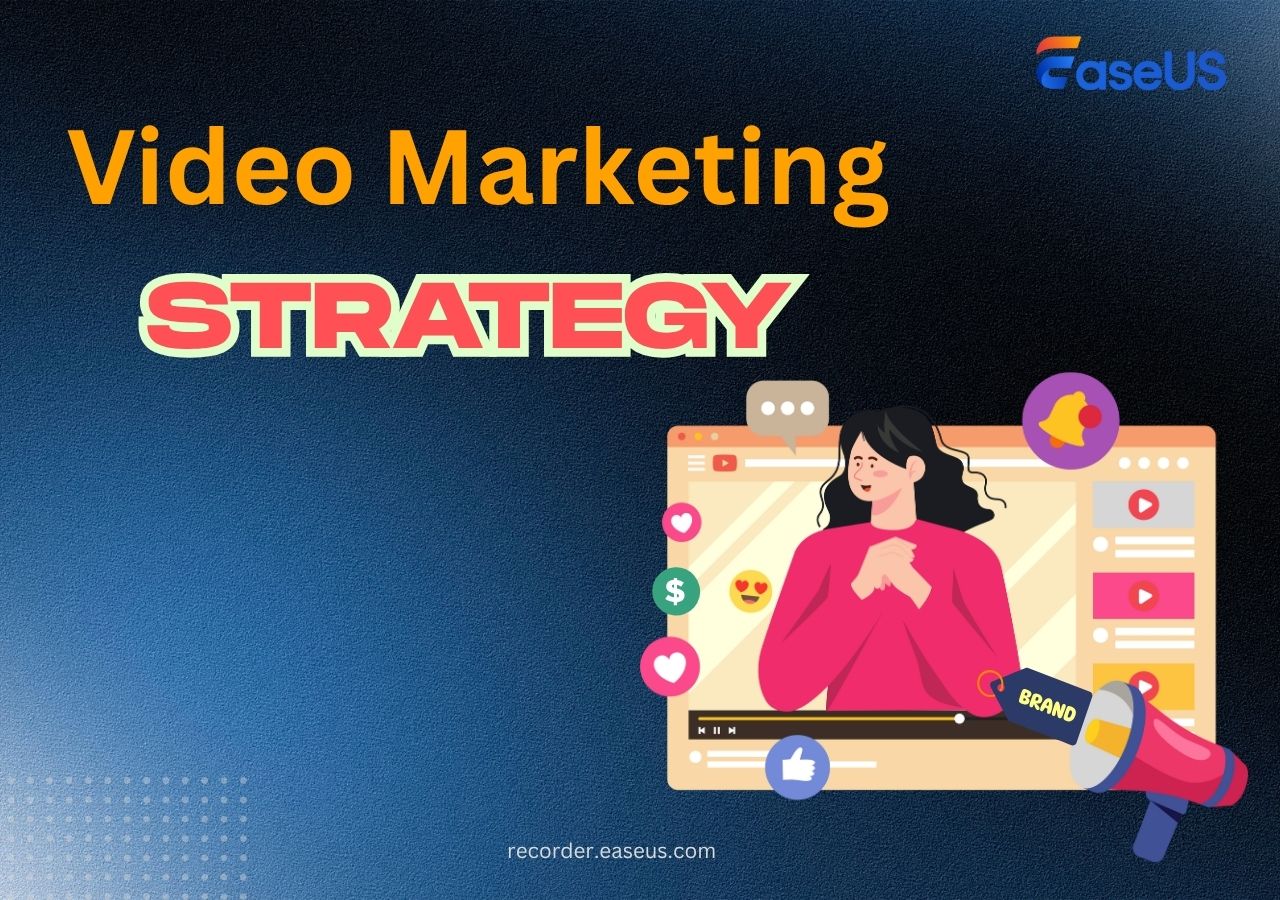
As digital consumption continues to evolve at a rapid pace, video has become the centerpiece of modern marketing strategies. Whether it's short-form social content, branded storytelling, or educational product explainers, video offers an unmatched ability to capture attention and drive meaningful engagement. Consumers now expect visually rich experiences, pushing brands to rethink how they connect and communicate.
Video marketing has transformed how businesses approach the entire customer journey, from raising awareness and building trust to onboarding users and retaining loyalty. Its versatility spans across industries and audience segments, from B2C lifestyle brands to complex B2B solutions. With platforms like YouTube, TikTok, and LinkedIn prioritizing video, it's no longer optional; it's essential.
This report, from EaseUS team, explores the current video marketing landscape, key factors fueling its growth, and actionable strategies for marketers. We also highlight emerging technologies shaping the future of visual content, helping you stay ahead in a video-first digital economy.
1. Introduction & Methodology
Video marketing is the strategic use of video to promote brands, products, or services across digital platforms. It has rapidly evolved into a dominant force across digital channels, shaping how brands engage, educate, and convert audiences. Its growing influence is redefining the landscape of online communication and content consumption.
This report focuses on marketers, business owners, and content creators seeking to leverage video in diverse scenarios, from brand storytelling to product promotion and customer engagement.
Our insights are drawn from a combination of market surveys, performance data, and industry case studies collected from 2023 - 2025 by Wyzowl, Statista, HubSpot, Demandsage, Wistia, and more. All data sources are verified, and key trends are interpreted with the help of expert analysis and audience behavior tracking.
If this insight aligns with your strategy, share it with your team or network.
2. Global Landscape & Trends of Video Marketing
2.1 The Rise and Impact of Video Marketing
Over the past decade, video has evolved from an optional marketing tool to a critical component of digital strategies worldwide. Fueled by mobile-first consumption and short-form video platforms like TikTok and YouTube Shorts, video marketing now drives engagement, education, and conversion across industries.
- According to Wyzowl: 89% of businesses use video marketing (up from 61% in 2016), and 95% of video marketers confirm video's key role in their strategies. Notably, 68% of marketers not yet using video plan to adopt it by 2025.
- HubSpot reports that 13.99% of marketers will increase video marketing budgets in 2025, reflecting global confidence in video's ROI and influence.
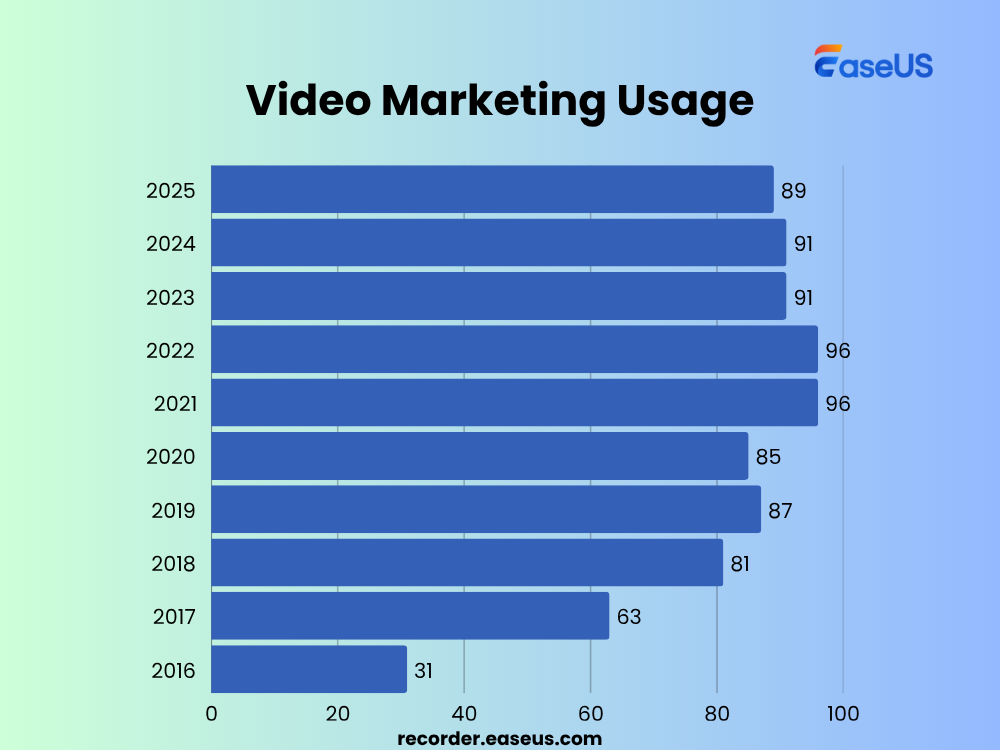
This widespread adoption underscores video's critical role across industries and marketing functions. DemandSage says that several factors are driving this rapid adoption: platform shifts toward short-form, algorithm-driven videos on YouTube Shorts, TikTok, and Instagram Reels, which 66% of consumers find most engaging; and mobile-first consumption, with over 75% of video views occurring on mobile devices.
Popular platforms include YouTube (69%), LinkedIn (61%), Instagram (51%), and Facebook (44%), each serving distinct audience needs.
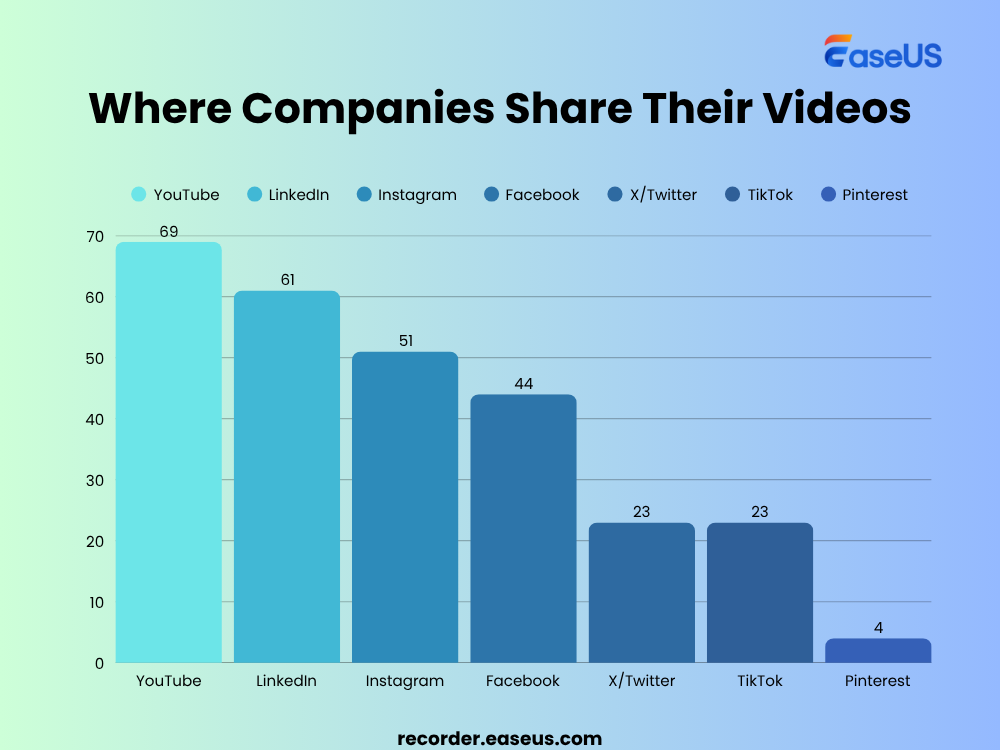
(Source: Wistia, 2025)
💡Pro Tip: In today's attention economy, video marketing is no longer optional; it's mission-critical for storytelling, education, and conversion across nearly every industry. Video consistently outperforms text and images on social media in click-throughs, shares, and watch time.
2.2 Market Size, Growth Momentum, and Consumption Trends
Video marketing spending is expanding rapidly across all regions. Statista projects global video advertising expenditure to reach $207.52 billion in 2025 and surpass $267.98 billion by 2029, growing at a CAGR of 6.6%. North America leads in market size, while Asia-Pacific exhibits the fastest growth, driven by mobile content consumption in markets like India, China, and Southeast Asia.
- Digital video ads on platforms such as YouTube, Instagram, and Connected TV represent increasing budget shares, from brand storytelling to performance marketing.
- A 2024 Wyzowl survey reveals 78% of brands intend to increase video production, focusing on short-form and shoppable content.
- Dash.app data shows online videos reach 92% of internet users globally. Videos under one minute generate the highest engagement, with viewers watching an average of 16 seconds. Moreover, 44% of consumers prefer short explainer/product videos over longer formats.
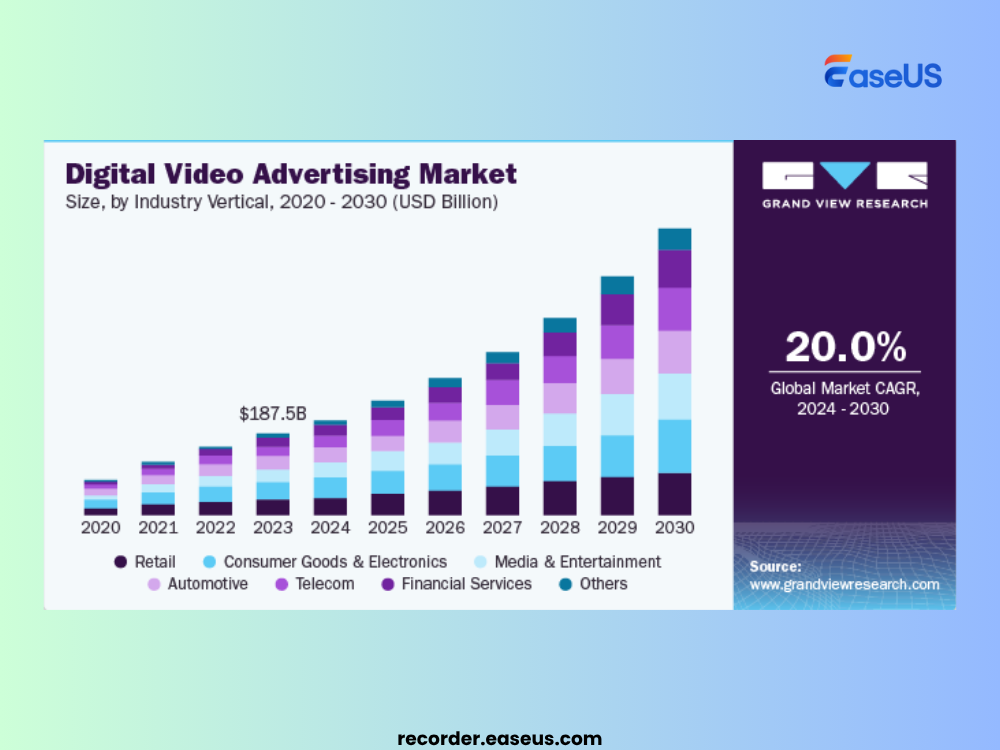
(Source: Grand View Research, 2025)
2.3 Industry Use Cases and Emerging Opportunities
As video marketing matures, its application has diversified across industries. From driving sales to supporting education and healthcare, video is now a strategic asset in multiple verticals. This section explores key use cases and highlights fast-emerging growth opportunities shaping the future of video content.
1️⃣Video marketing's versatility spans multiple sectors:
- E-commerce & Retail: Short demos, unboxing, and shoppable videos enhance conversions and cart values.
- B2B & SaaS: Explainers, customer testimonials, and webinars nurture leads and speed onboarding.
- Education & Training: Microlearning and animated explainers boost retention and learner engagement.
- Healthcare & Wellness: Brand videos support virtual consultations and patient education.
- Entertainment & Media: Trailers, behind-the-scenes, and influencer content drive global campaigns.
2️⃣Growth opportunities include:
- Short-form video dominance, with 29.18% of marketers actively using TikTok, Instagram Reels, and YouTube Shorts (Source: HubSpot, 2025).
- AI-powered video tools like Synthesia enable scalable, cost-effective production.
- Interactive and shoppable formats embed product links, accelerating direct sales.
- Connected TV (CTV) advertising spend is forecasted to exceed $10 billion by 2026, offering premium storytelling channels. (Source: Statista, 2025)
- Live video streaming is growing, with 38% of marketers using live events to engage audiences (Source: Wistia, 2025).
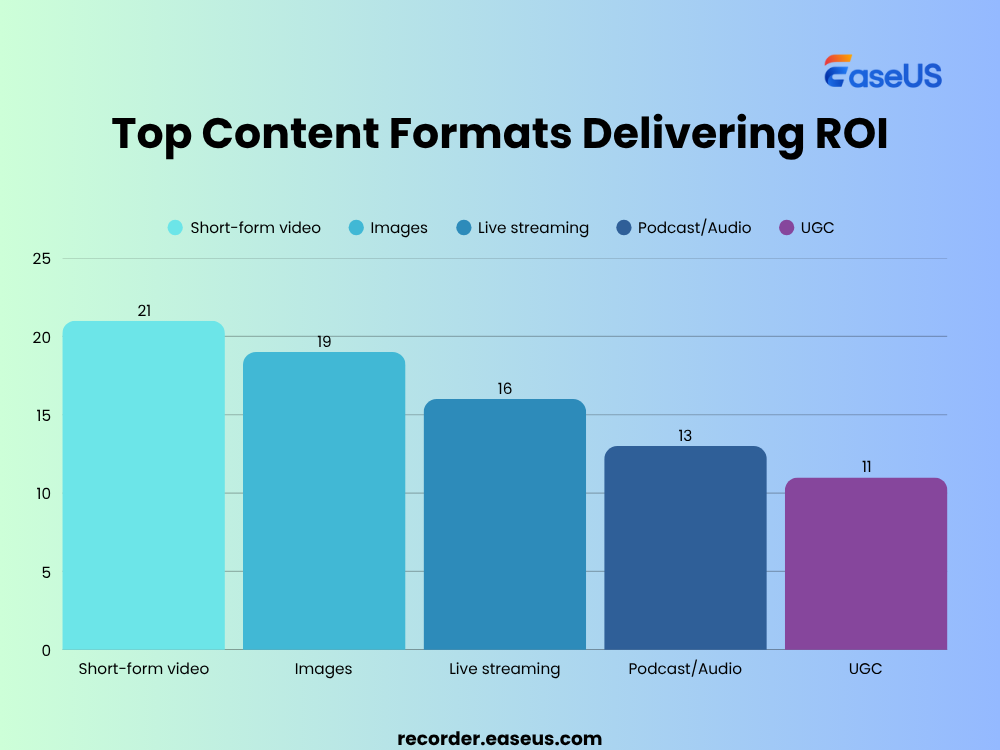
2.4 Regional Market Differences and User Behavior
While video marketing is a global phenomenon, regional behaviors and platform preferences vary significantly. Understanding these differences is critical for localization and strategy adaptation. This section breaks down user trends and platform dynamics across the U.S., Europe, and Asia-Pacific.
- United States: Largest and most mature market, with $289.76 billion projected revenue in 2025. OTT platforms (Netflix, Disney+, Hulu) dominate, generating $146.25 billion. Users favor high-production, long-form content, with increasing interest in vertical formats via TikTok and Shorts. (Source: Statista, 2025)
- Europe: Projected $144.83 billion revenue in 2025; traditional TV remains strong, but OTT adoption grows steadily. User penetration reaches 78.9% by 2025, with culturally tailored and subtitled content widely consumed. (Source: Statista, 2025)
- Asia: Fastest growing region, $207.94 billion projected revenue in 2025. OTT leads with $113.59 billion share. Mobile-first audiences prefer interactive, short-form, and entertainment-centric videos. Video commerce, especially live shopping, is particularly popular in China. (Source: Statista, 2025)
If this insight aligns with your strategy, share it with your team or network.
3. Critical Factors Driving Video Marketing
To understand the rapid growth and effectiveness of video marketing, it is essential to examine the key factors that fuel its momentum. These drivers range from evolving user behaviors and digital consumption trends to technological advancements and data-driven strategies.
3.1 User Behavior and Digital Consumption Trends
✅The Rise of Short-Form Video & Intensified Attention Competition
In recent years, short-form video has rapidly emerged as a dominant format in digital content consumption. Over 73% of marketers identify short videos (ranging from 30 seconds to 2 minutes) as their most crucial video content type (Wyzowl, 2024). User preference for this format continues to rise, driven by the explosive growth of platforms like TikTok, YouTube Shorts, and Instagram Reels, which have significantly diversified video consumption scenarios.
Short videos cater to modern audiences' fragmented attention spans with their concise length, fast pace, and ability to deliver messages directly and impactfully. HubSpot reports that 64% of consumers prefer watching videos under one minute in length (HubSpot, 2025). While this format boosts completion rates, it also intensifies the battle for user attention. To stand out, brands must deliver highly refined and precisely targeted content that captures viewers within seconds.
✅Personalized Content and Community-Driven Engagement
As recommendation algorithms grow more sophisticated, personalized content consumption has become the norm. Wyzowl notes that 85% of viewers prefer watching videos aligned with their personal interests and needs. Platforms leverage behavioral data to build detailed user profiles, enabling precise delivery of tailored content.
Meanwhile, community-driven dynamics are enhancing engagement and loyalty. Users are no longer passive viewers, and they actively comment, share, and even remix content, fostering a viral, social distribution effect. HubSpot reports that over 40% of consumers are influenced by community recommendations when deciding to watch or purchase based on video content. This social-driven trust loop amplifies both reach and credibility.
3.2 Personalized Content and Community-Driven Engagement
With the continuous advancement of algorithmic recommendation technologies, personalized content consumption has become the norm for video viewers. According to Wyzowl's 2025 report, 85% of viewers prefer watching videos that closely match their interests and needs. Platforms leverage user behavior data to build precise audience profiles and deliver customized video content, achieving highly efficient alignment between content and user demand.
In addition, community-driven content distribution mechanisms are strengthening user engagement and loyalty. Users have evolved from passive content consumers to active participants who comment, share, and create derivative content, generating a powerful social viral effect. HubSpot data shows that over 40% of consumers choose to watch and purchase video content based on recommendations and word-of-mouth within communities. This interest- and community-based dissemination enhances both the trustworthiness and reach of video content.
Furthermore, the adoption of AI technology is accelerating this trend. A recent survey indicates that the percentage of professionals using AI for video production has jumped from 18% last year to 41% this year, with an additional 19% planning to start using AI shortly (Wistia, 2025). AI is becoming a critical tool for creators to meet attention challenges and achieve differentiated expression.
3.3 Data-Driven Content Marketing & Intelligent Distribution
Accurate data analytics enable brands to gain deep insights into user behavior and preferences, supporting precise audience segmentation and content refinement. Platforms like YouTube and TikTok offer extensive metrics—watch time, engagement rate, click-throughs—that empower marketers to tailor video content to the right audience.
Intelligent distribution leverages machine learning algorithms to optimize video ad placements. Through retargeting, lookalike audiences, and cross-platform programmatic buying, brands can reach high-intent users with greater precision. Studies show that smart targeting techniques can boost video ad conversion rates by 30–60% compared to traditional methods.
In summary, data-driven strategy and intelligent distribution are now central pillars of successful video marketing. As technologies continue to evolve, the industry is moving toward an era of hyper-personalized, performance-optimized video at scale.
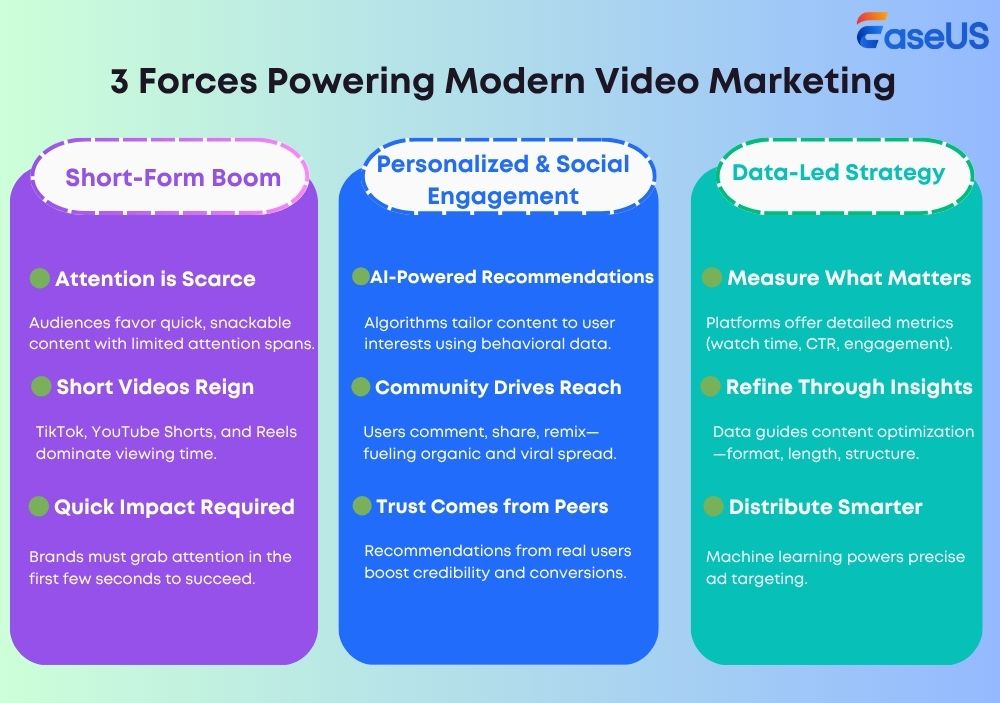
4. Video Marketing Strategy Framework & Practical Guide
Nowadays, video content has become the mainstream medium for communication. Constructing a systematic video digital content strategy has become one of the key factors for enterprises to enhance their market competitiveness. An efficient video marketing strategic system needs clear goals and audience insights, and covers a complete closed loop from content planning to distribution management, and from video production to effectiveness evaluation.
This chapter will analyze the core methodology and practical path for enterprises to implement a video content strategy from six key dimensions.
4.1 Goal Setting & Audience Research
For marketers, the first step to successful video marketing is to define your goals and understand the audience.
4.1.1 Defining Clear Objectives in Video Marketing
Clear goals provide a precise direction for video marketing campaigns. They not only guide content creation but also enable accurate performance evaluation. Depending on a company's development stage and communication intent, video marketing objectives can generally be categorized into three types:
1. Brand Awareness
Aimed at increasing visibility and emotional connection with the target audience. These videos often emphasize storytelling and strong visual identity to build brand perception and communicate core values. For example, Coca-Cola's annual holiday brand videos successfully reinforce the brand's association with warmth and sharing.
2. Lead Conversion
Focused on driving specific user actions such as clicks, sign-ups, or purchases. These videos are often concise and highlight product value and real-world use cases. For instance, a SaaS company boosted its sign-up rate by 42% using product demonstration videos that shortened the customer decision-making process.
3. User Education
Designed to help users better understand and utilize a product or service, especially in cases of complex features or technical offerings. Microsoft's Office tutorial series is a strong example, helping users adopt key features quickly and significantly reducing customer support requests.
Choosing the right objective should align with the company's market strategy and the customer journey stage. Additionally, it ensures that subsequent steps such as content planning, distribution, etc., are strategically aligned.
4.1.2 SMART Goal Principles and Applications
Once the current goal type is defined, the SMART framework can be applied to set specific and effective goals. This is a critical step to ensure the success of any video marketing campaign. The SMART method includes the following elements:
1. Specific
The goal should be clear and well-defined. Avoid vague or broad objectives. A specific goal provides direction and helps the team focus.
Example: "Increase sales of Product A by 20% through video marketing within the next three months.”
2. Measurable
The goal must include measurable criteria to track progress and success, such as using key metrics such as video views, click-through rates (CTR), and conversions. Measurable goals allow marketers to monitor performance and adjust strategies in real time.
3. Achievable
Goals should be realistic and attainable based on available resources and capabilities. Avoid setting overly ambitious targets.
For example, assess whether the objectives can be achieved within the specified timeframe, given current resources and staff capabilities.
4. Relevant
The goal should align with the company's overall strategy and contribute to core business objectives. Ensure that the video marketing goal supports brand awareness, sales, or customer engagement efforts.
5. Time-bound
Set a clear deadline to create urgency and enable performance tracking.
Example: "Achieve the goal by December 31, 2025."
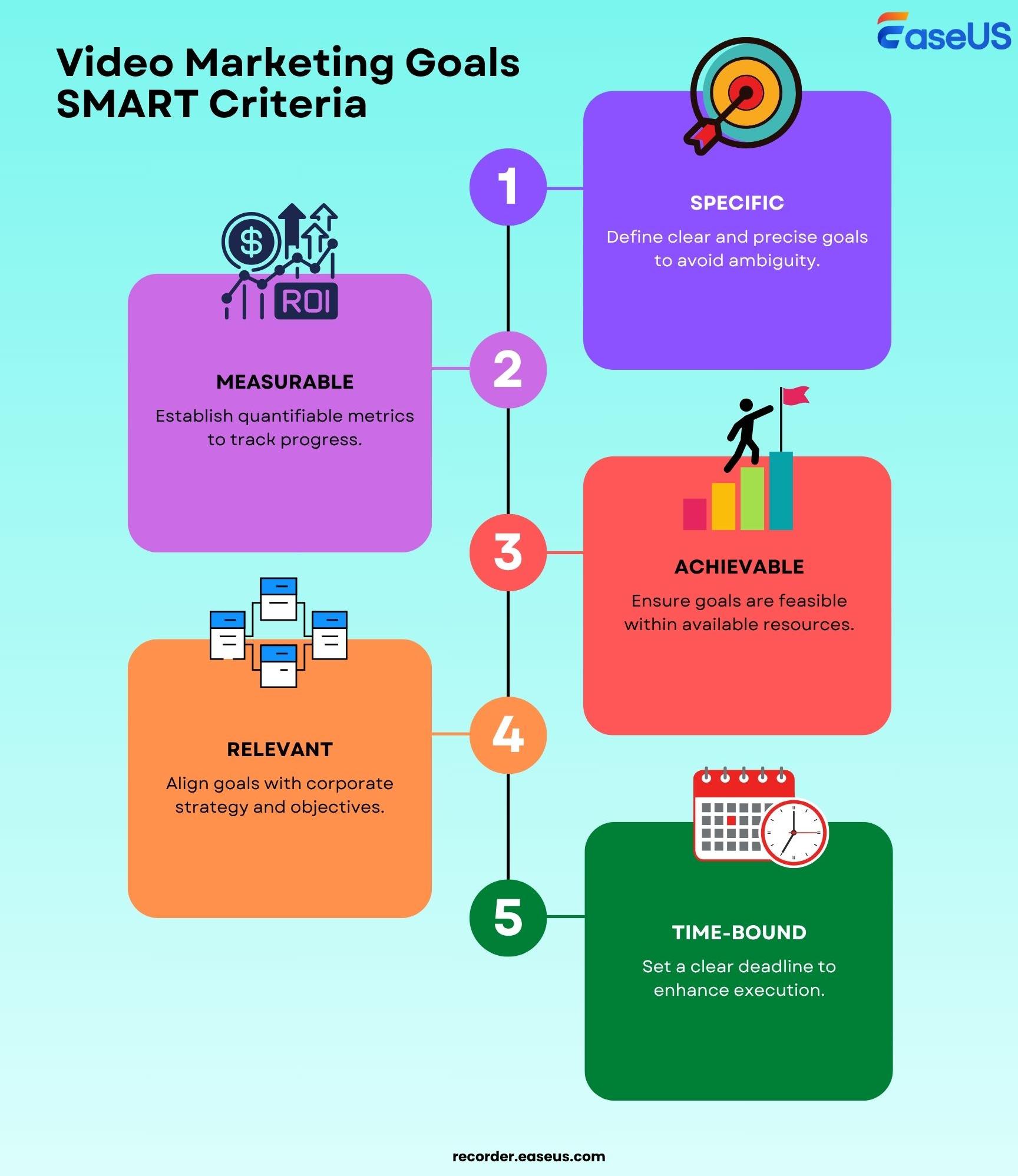
4.1.3 Build Professional User Profiles
Understanding the audience ensures that the video content aligns with their interests, needs, and behaviors, thereby increasing the video's appeal and reach. Only when the video content effectively reaches and resonates with the target audience can the marketing campaign achieve its intended goals and drive the growth of the brand or business.
1️⃣Audience Portraits Core Value
1. Target Audience Identification
By analyzing factors such as age, gender, occupation, and interests, brands can clearly define the audience their videos are intended to serve, ensuring precise content delivery.
2. Improved Content Relevance
Tailor videos based on users' interests and pain points to enhance engagement and interaction rates, while minimizing content waste.
3. Alignment with Customer Journey Stages
- Awareness Stage: Increase brand exposure through brand introduction and educational videos.
- Consideration Stage: Deepen user understanding with product demonstrations and customer testimonials.
- Decision Stage: Drive purchases with promotional offers and buying guide videos.
- Retention Stage: Strengthen customer relationships with user stories and loyalty program videos.
4. Enhanced Conversion and ROI
Accurate content matching helps guide users quickly from awareness to purchase, ultimately improving overall return on investment.
2️⃣Practical Implementation Path
1. Data Collection & Analysis
Leverage tools like Google Analytics, YouTube Analytics, and social media insights to gather user behavior and preference data.
2. Behavior Tracking & Feedback Analysis
Use platforms like Hotjar to track how users interact with video content, and combine this with user comments to continuously refine the content strategy.
3. Surveys to Supplement Insights
Deploy surveys that include questions on viewing preferences, usage habits, and purchase motivations to obtain qualitative insights and build a more comprehensive user profile.
4. Persona Development
Integrate collected data to build representative user personas (e.g., "Fitness Enthusiast Li": a 25-year-old male office worker who enjoys short fitness videos and is price-sensitive about high-end equipment), clarifying their background, goals, and media preferences to guide content creation.
5. Stage-Based Content Strategy
Design content strategies based on customer journey stages, aligning video types, distribution channels, and publishing schedules to optimize conversion efficiency.
3️⃣Use Case (Fitness Equipment Brand)
1. Profile Construction: A 25-year-old male office worker who loves fitness and frequently watches related content on YouTube/Sibili. He is interested in high-end products but is concerned about after-sales service.
2. Content Implementation:
- Awareness: Release a brand introduction video.
- Consideration: Demonstrate product features and effects.
- Decision: Launch a limited-time offer and a purchase process video.
- Retention: Share user stories of fitness achievements to enhance engagement.
If this insight aligns with your strategy, share it with your team or network.
4.2 Video Content Strategy & Video Types
This section aims to create content planning and select suitable video types for various marketing scenarios to ensure content is attractive, targeted, and convertible, driving the efficient operation of the overall video marketing system.
1️⃣Video Content Funnel and Strategy
The content funnel is a strategic model that layers content types and features based on the user's behavioral stages journey from "first contact with the brand" to "final conversion and repurchase." This model is generally divided into three layers:
|
Funnel Stage |
Meaning |
User Status |
Content Objectives |
|
TOFU |
Top of the funnel |
Potential users who are not yet familiar with the brand |
Attract attention, increase brand awareness |
|
MOFU |
Middle of the funnel |
Users who have a preliminary understanding of the brand and are beginning to consider the product |
Educate users, build trust, deepen interest |
|
BOFU |
Bottom of the funnel |
Users who are ready to make a purchase decision |
Strengthen persuasion, promote conversions, and drive action |
This logic is adopted by YouTube, Meta, and Google, which effectively boosts click-through rate, dwell time, conversion rate, and CLV in multi-platform video marketing. The content funnel is the "fulcrum" of the video marketing strategy. Through the structured content strategy of "content funnel + user journey", companies can effectively and accurately identify the psychological needs of users at each stage, optimize content delivery logic and resource allocation, and improve content usage efficiency and ROI (return on investment).

2️⃣Core Video Types and Application Scenarios
Guided by the content funnel model, different types of video content each carry specific strategic functions. Below is an analysis of six common and core video types, supplemented by specific scenarios and practical application cases.
1. Brand Videos
Brand videos are the most expressive video type during the TOFU phase. They typically focus on emotional storytelling, visual style, and corporate values, enhancing audience identification and retention. For example, 42% of companies still use brand advertising videos as their core marketing material (Source: Wyzowl).
- Typical scenarios: brand upgrades, company anniversaries, holiday marketing, and large-scale communication campaigns.
- Suitable platforms: YouTube, Instagram, Facebook, LinkedIn, TV commercials, and official website homepages.
- Example: Coca-Cola's annual Christmas commercials, through the integration of family reunions and warm atmospheres with the brand logo, continuously reinforce its brand philosophy of "sharing happiness."
2. Product Demo Videos
Product demo videos clearly display the functions and highlights of a product. They are commonly used for new product launches, SaaS platforms, or complex product introductions to enhance understanding and the willingness to purchase. According to Wyzowl data, 48% of businesses use product demo videos as sales support content.
- Typical scenarios: new product launches, SaaS software promotion, and complex feature explanations.
- Suitable platforms: official website, YouTube, LinkedIn, and App Store product pages.
- Case in point: Notion's official demo video demonstrates the multi-functional collaboration process, helping users quickly master the usage logic and stimulate registration behavior.
3. Tutorial & How-To Videos
These How-To & Explainer Videos span the MOFU BOFU stages. They simplify complex information by providing step-by-step instructions or animated demonstrations to educate users, unlock features, and lower the barrier to entry, thereby improving user retention. According to Statista, approximately 25.6% of internet users will watch tutorial or how-to videos in 2024.
- Typical scenarios: digital tools, consumer electronics, app usage tutorials, and customer support. Suitable platforms: YouTube, the official website help center, TikTok, and others.
- Use Case: Canva's tutorial video system covers the entire process from registration to advanced features, helping users quickly get started and complete their first creation.
4. Customer Testimonials & Case Studies
This type of video is a key conversion tool during the buy-in-first-out (BOFU) phase. Through real customer stories, it builds trust and social recognition, enhances brand credibility, addresses the "trust gap" among potential customers, and increases purchase intent. 60% of companies consider this type of video a key way to build trust and boost conversions.
- Typical scenarios: B2B marketplaces, SaaS solutions, and high-value transactions.
- Example: Salesforce customer success stories showcasing implementation results.
- Compatible platforms: LinkedIn, official website homepages, email embeds, online meetings, etc.
5. Short-form Videos
Short videos are a powerful tool for attracting traffic and boosting engagement during the TOFU phase. Their flexible content format, fast-paced pace, and short user engagement times, along with high interaction frequency, help brands connect with their users, making them suitable for a wide range of industries. 69% of companies have incorporated short videos into their core social media video marketing efforts.
- Typical use cases: Daily social content, light brand exposure, and event promotion.
- Compatible platforms: TikTok, Instagram Reels, YouTube Shorts, and Rednote.
- Example: Duolingo's humorous TikTok videos build brand affinity and drive downloads.
6. Live Videos
Live Video content integrates "real-time, participation, and on-site sales atmosphere" and is a powerful catalyst for BOFU conversion. It drives immediate user action through live Q&A, limited-time offers, and interactive commenting.
- Typical scenarios: e-commerce promotions, new product launches, online press conferences, and KOL collaborations.
- Compatible platforms: TikTok Live, Amazon Live, Facebook Live, Instagram Live, Shopee Live, Lazada Live, and Twitch

In addition to the six core video types mentioned above, promotional and event videos, Q&A videos, and behind-the-scenes videos also play a crucial role in actual operations.
- Promotional videos are often used for holiday sales, limited-time events, and other scenarios to inspire user action quickly.
- Q&A videos focus on answering common questions and improving customer support efficiency, making them suitable for use in official website help centers or YouTube channels.
- Behind-the-scenes or team culture videos showcase the brand's daily life, production processes, and real-life stories, fostering user trust and brand affinity.
These contents also have irreplaceable supplementary value in improving user stickiness and enriching brand image.
4.3 Script Writing & Creative Development
In video marketing, a script isn't just a blueprint for content delivery; it's also a crucial bridge for emotional connection, brand building, and user engagement. The fusion of creativity and structure determines a video's appeal and conversion rate.
✅Script Structure & Logic: The Three-Act Format and the Golden 5 Seconds
An effective video script typically follows the classic three-act structure:
- Opening (Hook): Capture the viewer's attention within the first 5 seconds using a compelling question, visual shock, or situational intrigue - especially crucial for platforms like TikTok where scroll behavior dominates.
- Middle (Value Delivery): Clearly communicate your core value proposition, showcase product features, or unfold the narrative.
- Ending (Call-to-Action): Reinforce brand identity and lead viewers toward a clear and compelling Call-to-Action (CTA).
Additionally, Hook-based scripting is increasingly essential—particularly in short-form video. Whether it's curiosity, humor, or suspense, the first 3–5 seconds often determine whether the viewer continues watching or scrolls away.
✅Creative Expression & Brand Storytelling
Creativity in video marketing isn't about exaggeration, it's about relevance and resonance. Brand storytelling is a core strategy for increasing recall and building loyalty. Strong videos translate product messaging into emotional storytelling, often through:
- Real-life narratives or user perspectives, such as Apple's "Shot on iPhone" campaign, turn ordinary moments into emotionally compelling visuals.
- Techniques like humor, contrast, or suspense to overcome "ad fatigue" and maintain engagement.
For example, many Thai video advertisements are popular around the world for their unique creativity and unexpected storylines.
✅Localization & Contextualization in Video Marketing
In a globalized content ecosystem, video marketing must align with local cultural contexts and real-life usage scenarios:
- Localization: Adapt language, currency, character types, and cultural nuances.
- Example
- Coca-Cola's annual Chinese New Year advertising campaigns, emphasizing family reunions and joy, have gained high social media exposure over the years, making it a part of the "New Year atmosphere" for Chinese consumers.
- Contextualization: Show how the product fits naturally into daily life.
- Example
- Nike's "You Can't Stop US" video, released during the 2020 COVID-19 pandemic, highlighted resilience and the integration of exercise into daily life amidst challenging times by showcasing everyday sports activities around the world. The ad quickly garnered over 50 million views and was widely circulated on social media.
✅Designing Effective Calls-to-Action (CTA)
A well-placed CTA is the linchpin of video-driven conversion. To be effective, CTAs should be clear, action-oriented, and visually prominent:
- Start with imperative verbs like "Download Now" or "Start Free Trial.”
- Visually emphasize clickable elements—such as buttons or QR codes—for higher engagement.
- Place the CTA after the narrative climax to feel organic rather than forced.
- TikTok & Instagram Reels: Use prompts like "Swipe Up to Learn More.”
If this insight aligns with your strategy, share it with your team or network.
4.4 Video Production & Optimization Tips
No matter how creative a video is, it still needs to rely on efficient production and post-production optimization to ensure output quality and multi-platform compatibility.
✅ Production Process and Quality Management
The standard video production process includes five major stages:
- Pre-production: script confirmation, casting, and prop setup.
- Shooting: control composition, lighting, and audio quality to ensure usable footage.
- Post-production: shot editing, color adjustment, and subtitle embedding.
- Platform Adaptation: export ratio and duration versions based on platform requirements.
- Publishing and Feedback: test clarity, cover art, and subtitle accuracy before launch.
Quality Management Recommendations:
- Use storyboards to ensure consistent visual expression;
- Installing a review mechanism at key points to avoid rework;
- Controlling duration: Brand videos are recommended to be 60-90 seconds, while short videos should be kept under 15 seconds for easier sharing.
✅ Recommended Video Creation Tools
There are many video tools available on the market that help create high-quality videos.
For example, EaseUS RecExperts is an all-in-one video recording and editing tool that supports 4K HD recording and AI noise reduction, making it suitable for content creation such as product tutorials and software demonstrations.
At the same time, with the continuous development and advancement of AI technology, more powerful AI tools are playing a greater role in video production, such as the following AI-assisted tools:
- Descript and Wisecut: Automatic editing and pacing optimization.
- Subly and Captions.ai: Automatically generate multilingual subtitles, improving global dissemination efficiency.
- Runway ML: AI visual effects and background removal.
✅ Cross-Platform Adaptation & Brand Consistency
In a multi-platform environment, video content should be optimized in format and style based on the specific characteristics of each platform, while ensuring a consistent brand image. For example, different platforms have different requirements for content size, subtitle style, and interactive formats, which should be adapted accordingly. For example:
- YouTube: Suitable for long-form tutorials and branding videos. We recommend adding chapter navigation and SEO headlines.
- Instagram Reels & TikTok: Prioritize vertical content (9:16) with overlay text and popular audio tracks.
- LinkedIn: Prefers professional explainer videos and customer stories. We recommend adding English subtitles.
Maintaining brand consistency is crucial, including a unified logo, watermark, color tone, and voice style, which helps enhance brand recognition and trust.

4.5 Distribution Strategy & Multi-Platform Management
Accurately and efficiently delivering this video content to target audiences relies on channel strategy and operational cadence. Now, let's delve into the selection and operation mechanism of video distribution platforms.
1️⃣Different Platform Characteristics and Content Adaptation
Each platform has its own unique audience structure and content preferences, so videos require differentiated editing and presentation to better achieve the goals of building a social media video marketing strategy.
|
Video Platforms |
User Preferences |
Content Suggestions |
|
YouTube |
In-depth content, tutorials, and series |
Suitable for long-form videos, brand documentaries, and tutorials. |
|
YouTube Shorts |
Fast-paced, mobile-first, and story-driven |
Suitable for product highlights, challenges, and behind-the-scenes content under 1 minute. |
|
TikTok |
Creative, fun, and natively interactive |
Emphasize the opening hook, user-generated content (UGC), challenge topics, and music. |
|
Instagram Reels |
Aesthetic, emotional, and visually impactful |
Suitable for brand tonality, holiday events, and storytelling product showcases. |
|
|
Professional content, B2B stories, and customer success stories |
Ideal for customer case studies, interviews, company culture presentations, and product feature demonstrations. |
2️⃣Owned/Earned/Paid Media Strategy Combination
Build a comprehensive video marketing matrix:
- Owned Media: Brand-owned assets such as the brand's official website, official social media, and email lists. Suitable for publishing brand videos, tutorials, and customer case studies.
- Earned Media: User shares, comments, media coverage, and KOL word-of-mouth. Incentivize user-generated content (UGC) or leverage partnerships to drive organic reach.
- Paid Media: Paid promotions, including YouTube Ads, Instagram Promoted Posts, and TikTok Spark Ads, are suitable for increasing exposure and driving traffic.
3️⃣Managing Posting Times and Frequency
Optimal posting times should be optimized based on platform analytics (such as YouTube Analytics or Instagram Insights). Generally, Tuesday through Thursday, midday or evening, perform best.
Frequency Recommendations:
- TikTok: 3-5 posts per week, maintain a high level of activity;
- Instagram Reels & Stories: 2-3 posts per week;
- YouTube: 1-2 in-depth posts per month or 1 Short per week;
- LinkedIn: Optimally, post once per week, focusing on quality and industry relevance.
4.6 Performance Measurement & Optimization
After publishing high-quality videos, businesses need to evaluate the data and continuously optimize to determine which content performs best. Next, we will focus on key indicators, platform tools, and other aspects to help brands build a truly "data-driven" video growth system.
1️⃣Core KPIs and Evaluation Metrics
Set key metrics based on your video marketing goals:
|
Goal Type |
Key KPI Examples |
|
Brand Awareness |
Views, reach, average viewing time, completion rate |
|
User Engagement |
Likes, comments, reposts, follower growth, shares |
|
User Conversion |
Click-through rate (CTR), referrals, downloads, registrations |
|
Audience Quality |
Retention rate, return visit rate, audience demographics (gender, age, region) |
2️⃣Platform analysis tools and user feedback
The selection and integration of data analysis tools is crucial in evaluating and continuously optimizing video marketing effectiveness. To gain comprehensive insights into content effectiveness, user behavior, and conversion paths, analysis tools can be divided into the following three categories for coordinated use:
✅ Platform-Based Tools: Monitor Content Performance
- YouTube Studio & TikTok Analytics & Meta Insights: Views, retention, top clips, and engagement data.
- Google Analytics + UTM: Analyze user paths and conversion rates after a video is clicked.
✅ Multi-Platform Analytics Tools: Unified Management and Comparative Optimization
- Tubular Labs & Vidooly & Emplifi: Track content performance, audience demographics, and competitive data across multiple platforms.
- Sprout Social: Centrally analyze social media video data and engagement.
- Wistia & Vimeo Analytics: Ideal for private enterprise content, providing in-depth data like view heatmaps and bounce rates.
✅ Conversion Tracking Tools: Gain Insights into User Behavior
- Mixpanel & Amplitude: Track user behavior after a video (e.g., registrations, orders).
- Hotjar & Microsoft Clarity: Analyze user behavior on video pages through heatmaps and screen recordings.
- HubSpot: Integrate video into your marketing workflow to monitor conversions and user engagement.
3️⃣A/B Testing and Data-Driven Optimization
A/B testing can help us verify the effectiveness of different video elements (such as titles, thumbnails, and CTAs). Data-driven optimization ensures that decisions are based on real feedback rather than subjective judgment, thereby continuously improving view rates and conversion rates.
- Testing Elements: Video title, cover thumbnail, opening hook, CTA placement and content, presence of subtitles, etc.
- Implementation: Release versions A and B at different times and platforms, comparing click-through rates, watch time, conversion rates, etc.
- Continuous Optimization Cycle: Data Analysis > Strategy Adjustment > Retesting > Reoptimization.
For example, a brand could test two cover images for the same product short video: one featuring a "stunning scene" and one featuring a "practical function." This would determine user preferences and inform future editing styles and creative direction.
If this insight aligns with your strategy, share it with your team or network.
5. New Trends and the Future of Video Marketing
As the video marketing landscape continues to evolve at an unprecedented pace, new technologies and shifting consumer behaviors are reshaping how content is created, distributed, and consumed. Among these, Artificial Intelligence (AI) and Generative AI (AIGC) stand out as transformative forces driving innovation across the industry.
5.1 AI and AIGC-Driven Content Creation and Distribution
Artificial Intelligence (AI) and Generative AI (AIGC) are profoundly transforming how video content is produced and distributed. Intelligent content generation technologies can automatically create video scripts and visuals based on text input, while automated editing tools significantly shorten production cycles and improve efficiency. At the same time, personalized recommendation systems leverage deep learning algorithms to precisely deliver video content tailored to users' interests, greatly enhancing user experience and platform engagement.
Companies like EaseUS are actively exploring intelligent recording and editing technologies. By incorporating AI-assisted automatic editing, subtitle generation, and multi-platform adaptation, they are enabling content creators to automate and streamline production workflows, helping them quickly respond to diverse market demands.
5.2 The Rise of the Short-Form Video Economy and Social Commerce
Short-form video has become a key format in digital content consumption, with its commercial value rapidly unfolding. Monetization models for short videos are diverse, including advertising revenue, paid content, brand collaborations, and tipping. Meanwhile, the integration of live-stream shopping with short-form video has created a new social commerce ecosystem, where users can interact with live broadcasts and make instant purchases, driving rapid online sales growth.
Social platforms continuously enhance live-streaming and e-commerce features, empowering creators and brands to deliver immersive shopping experiences. Moving forward, the deep integration of short-form video and social commerce will further propel the digital economy and become a critical lever for brand marketing and sales.
5.3 Immersive and Interactive Video Experiences
With the maturation of Augmented Reality (AR) and Virtual Reality (VR) technologies, immersive video marketing is being tested across multiple industries. Brands use AR filters, virtual try-ons, and immersive displays to offer users novel visual experiences and emotional connections. Interactive videos increase viewer engagement and retention by enabling actions such as clicks, polls, and choose-your-own-adventure style story paths.
These innovative video formats not only enhance user experience but also provide marketers with new dimensions for audience reach and conversion. Looking ahead, immersive and interactive videos are poised to become important innovation directions in video marketing, driving deeper integration between content formats and user needs.
6. Challenges & Risks of Digital Video Marketing
6.1 Content Homogeneity & Innovation Bottlenecks
With 95% of video marketers see video as an important part of their overall strategy (Wyzowl, 2024), content saturation is inevitable. Many brands struggle to stand out due to repetitive formats and trends. Innovation becomes harder when audiences expect familiar hooks. Brands must balance consistency with creativity to avoid blending into a sea of similar content in a sea of similar reels and shorts.
6.2 Data Privacy, Compliance Risks & Platform Policy Shifts
Video marketing strategies often require user data to personalize content and improve targeting. However, evolving privacy regulations like the GDPR, CCPA, and COPPA significantly impact how brands collect and process data. TikTok's £12.7M fine in the UK for misuse of children's data highlights real regulatory risk (BBC, 2023). Marketers must also respond to shifting platform rules, like YouTube's 2024 AI content disclosure requirement, to avoid demonetization or bans. Failure to comply can result in demonetization or content removal, making legal awareness and proactive adaptation essential to safeguard brand reputation and channel viability.
6.3 Algorithmic Changes Affecting Visibility
Social platforms frequently tweak their algorithms, directly impacting video reach. For example, Instagram Reels' 2024 shift prioritized original content, penalizing repurposed TikToks. Creators relying on recycled content saw a 35% drop in views. Similarly, YouTube Shorts now favors vertical content with 100% viewer retention. These updates demand agile strategies—marketers must continuously test formats, optimize for platform-specific features, and track metrics to avoid losing engagement momentum.
If this insight aligns with your strategy, share it with your team or network.
7. Video Marketing Strategy Insights and Execution Plan
To succeed in today's competitive landscape, businesses and creators need clear, effective strategies. This section outlines key recommendations for optimizing video marketing, leveraging multiple platforms, and enhancing team collaboration.
7.1 Practical Recommendations for Businesses and Content Creators
In the face of increasingly intense content competition, businesses and content creators must develop differentiated video marketing strategies that emphasize brand positioning and core value propositions. By gaining deep insights into their target audience's true needs and viewing habits, they can create emotionally resonant content with memorable elements that enhance user engagement and brand influence.
Using efficient video production tools is a key step to reducing costs and improving productivity. For example, EaseUS RecExperts integrates screen recording, AI-assisted editing, automatic subtitle generation, and more, helping small and medium enterprises and content creators quickly produce high-quality content and boost creative efficiency even with limited resources.
Moreover, a data-driven continuous optimization approach should be maintained. By analyzing viewer data, engagement behavior, and campaign performance, businesses can timely adjust content structure, creative expression, and platform distribution strategies to improve conversion rates and return on investment (ROI).
7.2 Multi-Platform Collaboration and Content Operations
Video marketing should not rely on a single channel but instead adopt a "multi-platform collaboration" strategy that leverages the unique characteristics and user demographics of each platform. This enables large-scale content distribution and maximizes brand exposure. Businesses need to connect the entire chain from content planning, production, distribution, to analysis, achieving a closed-loop workflow from creation to optimization.
At the execution level, promoting cross-department collaboration is essential. Marketing, content, operations, and data teams should be integrated into a unified project framework to enhance cooperation efficiency. Through standardized processes and systematic tool usage, execution cycles can be shortened and resource utilization improved.
7.3 Resource Integration and Team Collaboration
An effective video marketing strategy relies heavily on internal resource integration and orderly team collaboration. Companies should clearly define the roles and responsibilities of different teams, content, marketing, and product, and establish a "co-creation, co-management, and co-evaluation" mechanism to ensure consistency and flexibility in strategy execution.
Additionally, a content asset management system should be established to categorize, tag, and version produced videos. This facilitates multi-channel reuse and content regeneration, extending the lifecycle value of content. For example, brand promotional videos can be repurposed into multiple short clips for social media, advertising platforms, or e-commerce channels, boosting dissemination efficiency and output returns.
8. Conclusion & Insights for the Future
As digital communication continues to evolve, video has firmly established itself as the most dynamic and influential medium for brands, educators, and content creators alike. The rise of mobile-first platforms, paired with the demand for short, engaging, and personalized content, is shaping a new era of visual storytelling.
Looking ahead, innovation in AI, real-time editing, and interactive formats will not only accelerate content creation but also redefine how audiences engage with brands.
In this context, EaseUS is committed to empowering marketers and creators through intelligent, user-friendly video tools that simplify production workflows and enhance content impact across platforms. Video marketing is no longer just a trend; it's the foundation of tomorrow’s digital strategies.
If this insight aligns with your strategy, share it with your team or network.
Was This Page Helpful?
